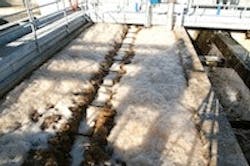Biological Denitrification Technology Aids Fragile Ecosystem
The Chesapeake Bay watershed, the largest estuary in the U.S., stretches across more than 64,000 sq miles, encompassing parts of six states and the District of Columbia. Called by some “one of the world’s most fragile ecosystems,” the long-term health of the watershed has been well documented for decades. Excess runoff and discharges of nutrients—particularly nitrogen and phosphorus—from farms, pavement, wastewater treatment plants and other sources have fueled the growth of algae blooms that impact water quality and aquatic life. As a result, the U.S. Environmental Protection Agency has placed the bay on its List of Impaired Waters.
Project Background
Of all the watershed states, Maryland has the most stringent regulations, limiting total nitrogen (TN) to 3 mg/L and total phosphorous (TP) to 0.3 mg/L. But other states, too, have introduced technologies to meet the state's point source caps. One technology, the TETRA Denite fixed-film biological denitrification process from Severn Trent Services, has frequently been chosen by plant operators to reduce high levels of nutrients discharged into the Chesapeake Bay.
For example:
- • In 2010, the Arlington County Water Pollution Control Plant in South Arlington, Va., was commissioned with a TETRA Denite system.
- • In 2013, the Baltimore Department of Public Works’ Patapsco wastewater treatment plant (WWTP) installed a Denite system—what was then the world’s largest fixed-film denitrification system. (Another WWTP, the Back River WWTP in Baltimore, will become the largest fixed-film denitrification system in the world at its expected 2015 commissioning, technology also provided by Severn Trent Services.)
- • The Celanese WWTP and the Georges Creek WWTP also have installed Denite systems in 2005 and 2010, respectively.
When the city of Cumberland, Md., in western Maryland needed to upgrade its Cumberland WWTP in order to comply with the Maryland Department of the Environment’s nitrogen and phosphorus permit limits, it drew on the experiences of all these plants. The project was designed by Whitman, Requardt and Associates LLP and was constructed by Carl Belt Inc. The Denite system was selected based on a rigorous evaluation process examining experience, operating data, guarantees and price.
The Technology
The Denite system is an economical solution for the removal of NO3-N and total suspended solids (TSS) in a single treatment step. The fixed-film biological denitrification process also serves as a deep bed filtration system capable of removing suspended solids to levels in compliance with most effluent requirements. The system integrates well with other plant treatment processes to provide TN and phosphorus removal. Denite is used as the final treatment step in the TN removal process to help facilities meet discharge limits of 3 mg/L.
Work on the plant upgrade began in 2009. The enhanced nutrient removal project incorporated upgrades to existing and new facilities, including:
- • A new denitrification filter facility consisting of eight 11-ft-8-in.-by-90-ft filters with a total filter surface area of 8,402 sq ft;
- • Replacement of existing clarifiers to enhance the clarification process and to maintain suitable secondary effluent quality for the downstream denitrification filters;
- • A new filter influent pumping station to transfer secondary effluent to the new denitrification filters;
- • A new post aeration facility to reintroduce dissolved oxygen into the plant flow prior to the chlorine contact tanks and discharge to the North Branch of the Potomac River;
- • A new methanol storage and feed facility to provide supplemental carbon required for the denitrification process; and
- • Modifications to existing secondary biological reactors to provide complete nitrification, and to use primary effluent carbon in order to reduce the amount of supplemental carbon (methanol) required in the downstream Denite filters.
Full-Scale Operation
The plant started operating in December 2010 and started methanol in the last week of December. The system was fully denitrifying by the end of January 2011 when the last piece of equipment was commissioned (Chemscan analyzer). The plant was designed for a maximum monthly flow of 25 million gal per day (mgd), an average daily flow 15 mgd and a peak flow of 40 mgd. The plant was designed to reduce nitrate-nitrogen from 15 mg/L to 1.0 mg/L or less; TSS from 10 mg/L to 5.0 mg/L or less; and phosphorus to less than 0.3 mg/L. In fact, the plant is reducing these nutrients to well below the design standards.
Paul Miller is engineering supervisor for Severn Trent Services. Miller can be reached at [email protected].
